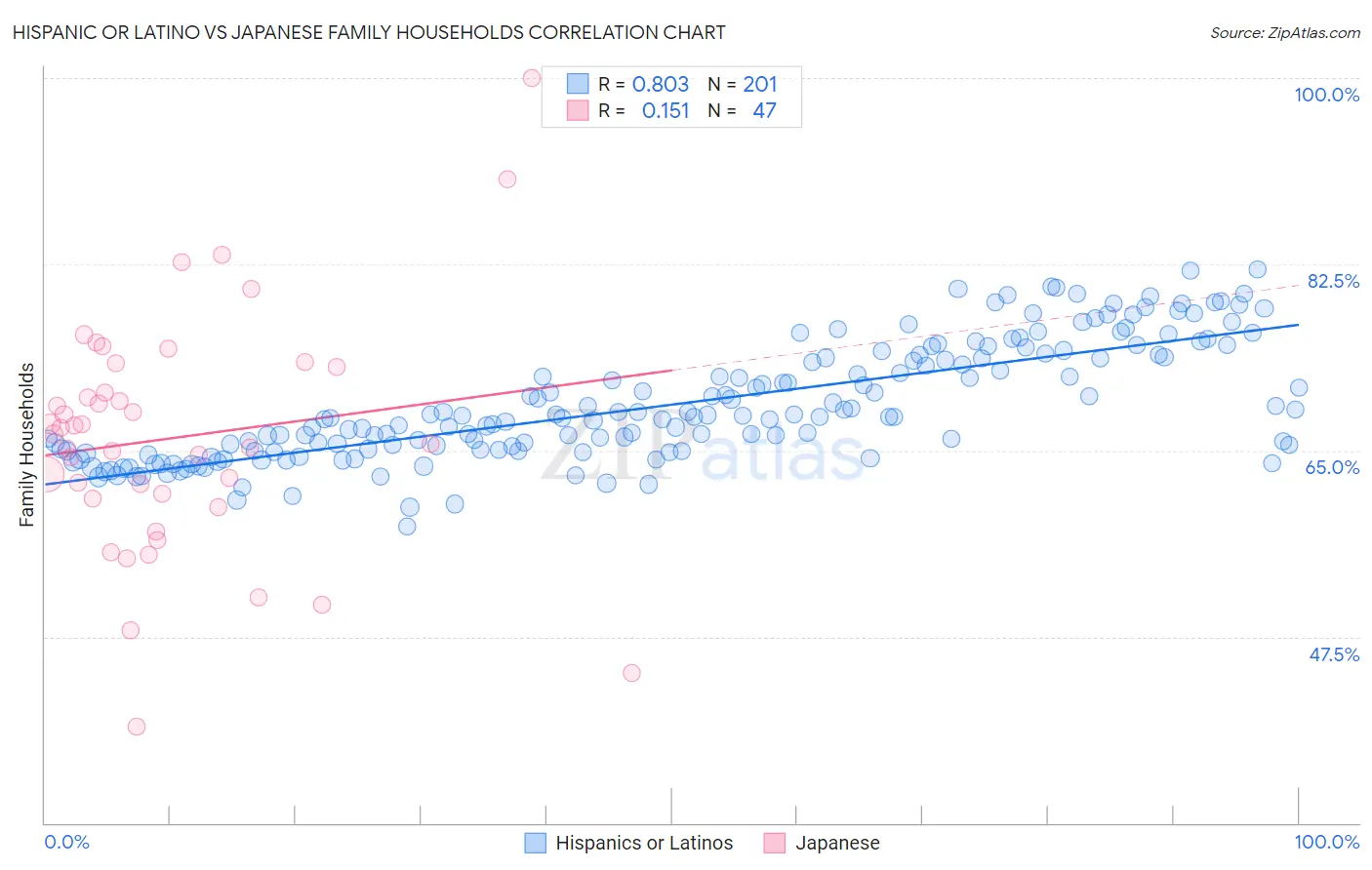Hispanic or Latino vs Japanese Family Households
COMPARE
Hispanic or Latino
Japanese
Family Households
Family Households Comparison
Hispanics or Latinos
Japanese
67.4%
FAMILY HOUSEHOLDS
100.0/ 100
METRIC RATING
27th/ 347
METRIC RANK
65.9%
FAMILY HOUSEHOLDS
99.9/ 100
METRIC RATING
68th/ 347
METRIC RANK
Hispanic or Latino vs Japanese Family Households Correlation Chart
The statistical analysis conducted on geographies consisting of 577,913,054 people shows a very strong positive correlation between the proportion of Hispanics or Latinos and percentage of family households in the United States with a correlation coefficient (R) of 0.803 and weighted average of 67.4%. Similarly, the statistical analysis conducted on geographies consisting of 249,074,128 people shows a poor positive correlation between the proportion of Japanese and percentage of family households in the United States with a correlation coefficient (R) of 0.151 and weighted average of 65.9%, a difference of 2.3%.

Family Households Correlation Summary
| Measurement | Hispanic or Latino | Japanese |
| Minimum | 57.8% | 39.1% |
| Maximum | 82.0% | 100.0% |
| Range | 24.1% | 60.9% |
| Mean | 69.3% | 66.2% |
| Median | 68.2% | 66.6% |
| Interquartile 25% (IQ1) | 65.0% | 60.5% |
| Interquartile 75% (IQ3) | 73.7% | 72.9% |
| Interquartile Range (IQR) | 8.7% | 12.4% |
| Standard Deviation (Sample) | 5.4% | 11.2% |
| Standard Deviation (Population) | 5.4% | 11.1% |
Similar Demographics by Family Households
Demographics Similar to Hispanics or Latinos by Family Households
In terms of family households, the demographic groups most similar to Hispanics or Latinos are Hawaiian (67.4%, a difference of 0.010%), Immigrants from India (67.4%, a difference of 0.040%), Immigrants from Nicaragua (67.5%, a difference of 0.050%), Immigrants from South Eastern Asia (67.5%, a difference of 0.080%), and Nicaraguan (67.4%, a difference of 0.080%).
| Demographics | Rating | Rank | Family Households |
| Inupiat | 100.0 /100 | #20 | Exceptional 67.8% |
| Cubans | 100.0 /100 | #21 | Exceptional 67.7% |
| Sri Lankans | 100.0 /100 | #22 | Exceptional 67.7% |
| Immigrants | Pakistan | 100.0 /100 | #23 | Exceptional 67.7% |
| Immigrants | South Eastern Asia | 100.0 /100 | #24 | Exceptional 67.5% |
| Immigrants | Nicaragua | 100.0 /100 | #25 | Exceptional 67.5% |
| Immigrants | India | 100.0 /100 | #26 | Exceptional 67.4% |
| Hispanics or Latinos | 100.0 /100 | #27 | Exceptional 67.4% |
| Hawaiians | 100.0 /100 | #28 | Exceptional 67.4% |
| Nicaraguans | 100.0 /100 | #29 | Exceptional 67.4% |
| Immigrants | Peru | 100.0 /100 | #30 | Exceptional 67.2% |
| Immigrants | Latin America | 100.0 /100 | #31 | Exceptional 67.2% |
| Nepalese | 100.0 /100 | #32 | Exceptional 67.2% |
| Salvadorans | 100.0 /100 | #33 | Exceptional 67.2% |
| Thais | 100.0 /100 | #34 | Exceptional 67.2% |
Demographics Similar to Japanese by Family Households
In terms of family households, the demographic groups most similar to Japanese are Fijian (65.9%, a difference of 0.020%), Filipino (65.9%, a difference of 0.020%), Malaysian (65.9%, a difference of 0.030%), Immigrants from Afghanistan (65.9%, a difference of 0.040%), and Costa Rican (65.9%, a difference of 0.060%).
| Demographics | Rating | Rank | Family Households |
| Danes | 100.0 /100 | #61 | Exceptional 66.0% |
| Central Americans | 100.0 /100 | #62 | Exceptional 66.0% |
| Immigrants | Indonesia | 100.0 /100 | #63 | Exceptional 66.0% |
| Pima | 99.9 /100 | #64 | Exceptional 65.9% |
| Costa Ricans | 99.9 /100 | #65 | Exceptional 65.9% |
| Fijians | 99.9 /100 | #66 | Exceptional 65.9% |
| Filipinos | 99.9 /100 | #67 | Exceptional 65.9% |
| Japanese | 99.9 /100 | #68 | Exceptional 65.9% |
| Malaysians | 99.9 /100 | #69 | Exceptional 65.9% |
| Immigrants | Afghanistan | 99.9 /100 | #70 | Exceptional 65.9% |
| Bhutanese | 99.9 /100 | #71 | Exceptional 65.9% |
| Portuguese | 99.9 /100 | #72 | Exceptional 65.8% |
| Laotians | 99.9 /100 | #73 | Exceptional 65.8% |
| Burmese | 99.9 /100 | #74 | Exceptional 65.7% |
| Houma | 99.9 /100 | #75 | Exceptional 65.7% |